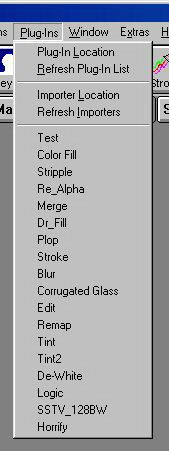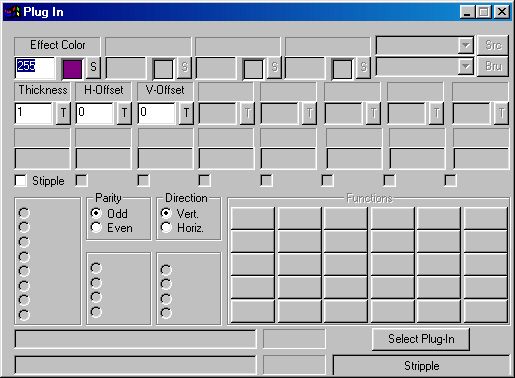| This is a child page. You can use Parent in the quick nav bar at the top or the bottom of the page to navigate directly back to the parent of this page. Some child pages are more than one level deep, and in that case will require more than one Parent click to reach the outermost document level. |
§ 16.97 - Plug-ins
| Quick Reference to Scripting Command |
|
a=LOADPLUG("path_and_file.wis") a=PUPALNC(Number_of_Colors_In_Palette) a=PUSTRING(which_string,"string") a=PURADIO(which_radio,selection[0-7]) a=PUCHECK(which_check[0-7],VALUE) a=PUFLOAT(which_float[0-7],value) a=PUINTEGER(which_int[0-7],value) a=PUPROFILE(which_profile[0-11],index[0-200],value[0-255]) a=PURGBA(which_rgba[0-3],r,g,b,a) a=PUPALRGB(which_palette[0-1],index[0-1023],r,g,b) a=PUCMD(command_number[0-29]) (immediately executes command button) Once the plug-in function is set up, call this to run it: a=PLUGIN() |
| Items in CAPS are 0/1 or ranges with more options than just 0/1. Ranges other than 0/1 are indicated by brackets, such as [0-2]. |
§ 16.97.1 - General Information
Each plug-in has different operating features and effects. Please see the documentation supplied with the plug-in for details.
§ 16.97.1.1 - Trending Plug-in Effects
All plug-in values and settings are trendable in the TimeLine. To trend most of the various user interface elements of the dialog, you would drag the operator into the timeline with the settings as you wish; for integer values, you also have the option of using the T button next to the value to set a trend graph.
Operator dialog controls that have a T button next to them offer animation functionality. T allows you to set that variable over a set of frames. Each frame of the animation can be thought of as a slice of time. The trends allow you to alter some, all, or none of the variables for a particular time slice. Variables that have multiple states can be set to any of a number of values in the trend. Variables that are either on or off can only have an on or off value in the trend. You will notice that the trend graphs have equidistantly spaced vertical lines. Each of these lines represents a frame in the animation. The number of frames can be altered using Sequence controls... in the TimeLine pull down menu. Animation lengths of 100 - 999 frames will be represented with a vertical bar being 10 frames, and animation length greater than 1000 frames will have a vertical bar for every 100 frames. Click here to view more information on Trends.
§ 16.97.1.2 - Area Selections
Plug-ins can (but might not) obey the area selections you make. Whether they do depends on what the plug-in does — this is an area where you would look to the documentation for the plug-in itself.
§ 16.97.1.3 - Color Transfer Modes
Plug-ins can (but might not) obey the color transfer modes you select. Whether they do depends on what the plug-in does — this is an area where you would look to the documentation for the plug-in itself.
For Developers
Technically speaking, in order for a plugin to take advantage of F/x's color transfer modes, the plugin must use the "write with mask" services provided to developers to write pixel data.
§ 16.97.1.4 - Saving Plug-in Settings
As long as the appropriate preferences setting remains checked, F/x will save all parameters for each plug-in you use as you change them. The plug-in settings are saved in a file called "WINFXpu.INI" in the "Windows" directory, wherever that is in your system. If you find that you are having trouble with one or more sets of plug-in values, it is possible that deleting this file may help. Be very careful to ensure that the file you delete is the one named here - you can cause major havoc by deleting the wrong file in the windows directory!!!
§ 16.97.1.5 - Loading Plug-Ins
To load a new plug-in, simply press the "Select Plug-in" button, navigate to the location where the plug-in is installed (we suggest c:data\plugins\) and select the desired plug-in module. Plug-ins should be files that end with the extension .wip

In addition, you can load plug-ins using the menu system; F/x searches out all installed plug-ins and places them on the menu for you to directly select. Note that selecting one from the menu does not pick the plug-in operator if another operator is selected, but it does load the specified plug-in so when you do change to the plug-in operator, the correct plug-in will already be loaded and ready to go.
§ 16.97.1.6 - Source and Brush Images
If a plug-in uses a source or brush image in its operation, the source and brush drop-down lists may be made available for you to select images.
§ 16.97.1.7 - Scripting
Any plug-in may be called using the scripting language. Please see the section on scripting for more details. The syntax of the plug-in specific commands are shown at the top of this page.
In general, you can set up as few as one dialog item, or all of them, or anywhere in between. You can load any plug-in from a script, and you can execute them as well.
§ 16.97.1.8 - Undo and Plug-ins
Undo entries will carry the name of the plug-in so you can tell what was going on.
§ 16.97.1.9 - Want to develop F/x plug-ins yourself?
Interested in developing plug-ins for F/x? It's really simple. When we developed our Easy-Plug technology, we knew that the development cycle for plug-ins for applications like Photoshop® was quite long, especially for first-time developers.
As a result, we made it our first priority to ensure that Easy-Plug would allow even a new developer to have a plug-in working within a few minutes, and performing custom effects within just a few minutes more. We have designed Easy-Plug so that everything except the effect itself is handled by F/x.
That means that F/x manages the dialog, the saving and loading of plug-in settings, the area selection, and much more - so developers can concentrate on hurting pixels!
To easily develop plug-ins for F/x, all you need is Microsoft® Visual C++ version 5 or later. The example plug-in projects are all in pure "c" (and we highly recommend this approach, as it is the only one we can give you support for), but you can, of course, use other languages, as long as they can create standard Windows DLL's and you know how to create the equivalant of the "c" approach in the examples.
For (a lot) more information, please see the Developer Plug-in Documentation.
, Previous Page . Next Page t TOC i Index o Operators g Glossary
Copyright © 1992-2007 Black Belt Systems ALL RIGHTS RESERVED Under the Pan-American Conventions
WinImages F/x Manual Version 7, Revision 6, Level A
